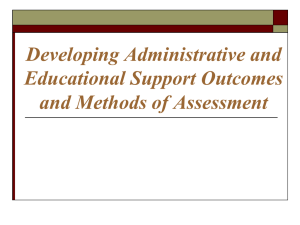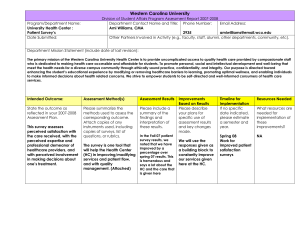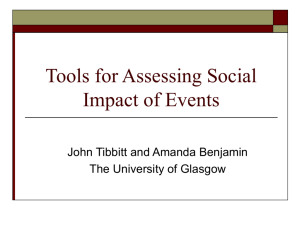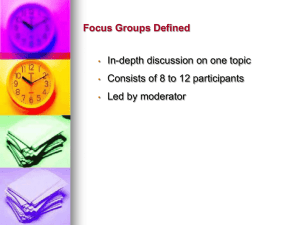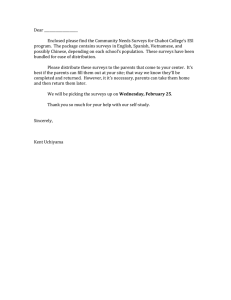Developing Administrative Methods of Assessment Assessment Measurement & Analysis
advertisement
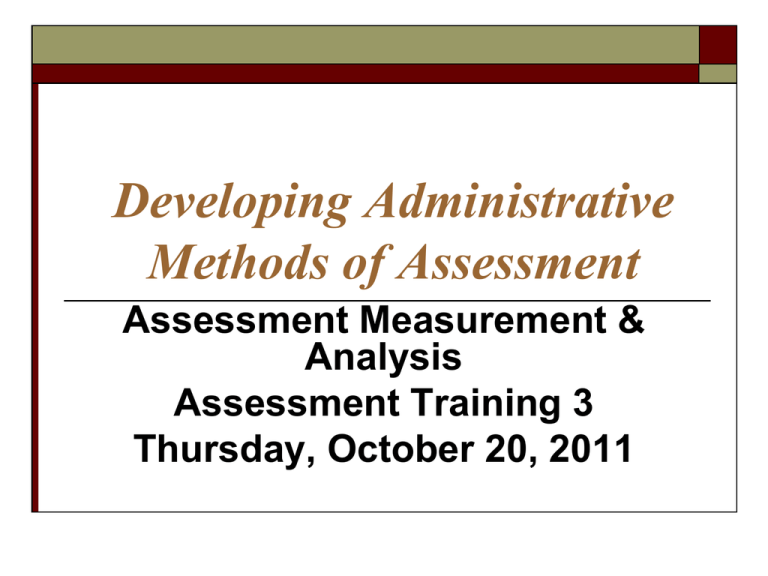
Developing Administrative Methods of Assessment Assessment Measurement & Analysis Assessment Training 3 Thursday, October 20, 2011 Methods of Assessing Outcomes Should provide an objective means of supporting the outcomes, quality, efficiency or productivity of programs, operations, activities or services Should indicate how you will assess each of your outcomes Should indicate when you will assess each outcome Provide at least two ways to assess each outcome Categories of Assessment Methods student learning direct assessments evaluate the competence of students indirect assessments evaluate the perceived learning exam scores, rated portfolios student perception, employer perception program or unit processes direct assessments evaluate actual performance error rates, time, cost, efficiency, productivity indirect assessments evaluate the perceived performance perceived satisfaction, perceived timeliness, perceived capability Examples of Direct Methods Samples of work assignments Projects or presentations Project embedded assessment Documented observation and analysis of behavior or performance Activity logs Case study/problems Interviews (including videotaped) Examples of Indirect Methods Questionnaires and Surveys Students Prospective Current Non-returning Alumni Customers Employees Describing Assessment Methods What are you going to use? Of and/or by whom? point-of-service, throughout the year, annually For what purpose? student, employee, focus group, customers Context (e.g., where or when)? presentation, assignment, survey, observation, performance rating desired intended outcome example: Observe employees annually for their level of efficiency in performing XYZ. Creating Assessment Methods What Who Where/When Outcomes Presentation Student Point-of-service Learning Assignment Alumni On the job Quality Portfolio Customer Throughout the year Timeliness Records Employee End of year Skills Project Mentor End of program Satisfaction Performance Focus group Biannually Preparation Survey Committees Observation Employer Efficiency Creating Assessment Methods What Who Where/When Outcomes Presentation Student Point-of-service Learning Assignment Alumni On the job Quality Portfolio Customer Throughout the year Timeliness Records Employee End of year Skills Project Mentor End of program Satisfaction Performance Focus group Biannually Preparation Survey Committee Observation Employer Efficiency Locally Developed Surveys institutional level alumni survey academic advising survey student survey image survey customer satisfaction survey (Xavier’s Institutional Effectiveness Survey) program or unit level customer surveys program-specific surveys advisory board surveys student surveys graduating senior survey employee exit interviews employee surveys Hints on Selecting Methods match assessment method with the intended outcome Maintenance will complete routine work orders in a timely manner. Review of completed work orders for length of time from open to closure. Review number of repeat work order requests for same service. Not related to outcome the assessment results should be usable Resident Assistants training effectively prepares them for their role as an RA. RAs will be surveyed at the end of the end of the academic year to determine the effectiveness of various aspects of the training. RAs will complete Resident Assistant Training program. Completion of the program will be recorded. Which is more useful of the two RA assessments? Hints on Selecting Methods results should be easily interpreted and unambiguous data should not be difficult to collect or access information should be directly controllable by the unit or program identify multiple methods for assessing each outcome direct and indirect methods qualitative and quantitative passive or active methods conducted by different groups identify subcomponents where other methods may be used that allow deeper analysis Hints on Selecting Methods use methods that can assess both the strengths and weaknesses of your department or initiative when using surveys, target all stakeholders build on existing data collection accreditation criteria program review Selecting the “Best” Assessment Methods (Best Practices) relationship to assessment — provide you with the information you need reliability — yields consistent responses over time validity — appropriate for what you want to measure timeliness and cost — preparation, response, and analysis time; opportunity and tangible costs motivation — provides value to student, respondents are motivated to participate other results easy to understand and interpret changes in results can be attributed to changes in the service After Identifying the Potential List of Assessment Methods You Need to… select the “best” ones consider possible performance targets for the future identify at least two methods for assessing each outcome balance between stretch targets versus achievable targets Examples of methods survey customers at the end of the year as to their satisfaction with services provided (indirect method) Customers will rate their likelihood of recommending service to others on an evaluation form provided upon completion of service. After Identifying the Potential List of Assessment Methods You Need to… develop assessment instruments surveys evaluation forms assignments scoring rubrics ideally you want them to be reliable, valid, and cheap approaches use external sources seek help from internal sources (e.g., University Planning , Institutional Research & Assessment Office) do it yourself the instrument may need to be modified based on assessment results Example Outcome: Clients will receive timely analyses of survey results. (Institutional Research) 95% of the results are properly analyzed and provided to the client within 3 - 4 weeks of survey administration as obtained by measuring the time it takes to deliver the survey results from the time of administration (direct measurement of timeliness). 95% of our clients are “satisfied” or “very satisfied” with the perceived timeliness obtained through a customer survey given at the point of service (indirect measurement of timeliness). Example Outcome: Increase the number of employers that participate in recruiting activities. (Career Services) Attendance will be logged noting overall employer attendance at all recruiting activities. (Direct method). Review acceptance responses to determine the number of different employers represented at recruitment activities. (Direct method). Example Outcome: Increase the total dollar amount of donations collected during the Capital Campaign. (Institutional Advancement) Count of total dollars received (Direct method) Review of dollars pledged during open campaign. (Direct method) Challenges and Pitfalls one size does not fit all — some methods work well for one program but not others do not try to do the perfect assessment all at once — take a continuous improvement approach based upon the three year cycle allow for ongoing feedback match the assessment method to the outcome and not vice-versa When is Assessment Successful? When people measure their performance, implement changes, and improve their performance When the program or service improves as a result of the assessment process
